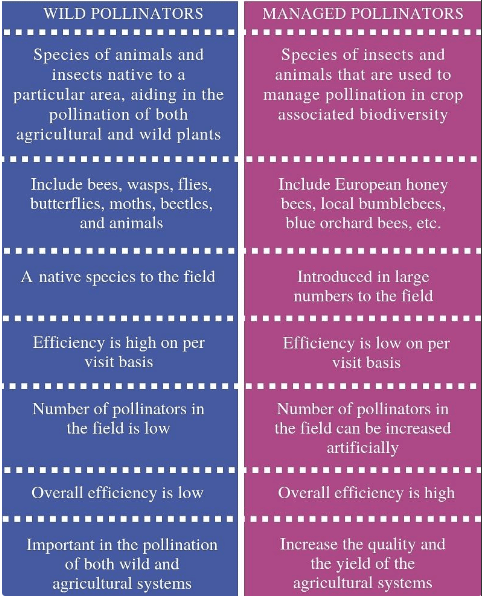Wild pollinators and Managed pollinators
 The main difference between wild and managed pollinators is that the number of wild pollinators is small in a particular area while the number of managed pollinators is high. However, the efficiency of wild pollinators is high at each visit, while the efficiency of managed pollinators is low each visit.
The main difference between wild and managed pollinators is that the number of wild pollinators is small in a particular area while the number of managed pollinators is high. However, the efficiency of wild pollinators is high at each visit, while the efficiency of managed pollinators is low each visit.
Wild and managed pollinators are two types of pollinators important in crop pollination. Most of the native insect species such as bees, wasps, flies, butterflies, moths, beetles, etc. are wild pollinators, while controlled pollinators include European honey bees, local bumble bees, and blue bees, etc…
This post includes:
- Wild pollinators Definition with characteristics, examples
- Managed pollinators with Definition, Characteristics, and Examples
- Similarities Between Wild and Managed Pollinators
- Difference between wild and managed pollinators
- Much more …
What are wild pollinators?
Wild pollinators are the species of animals and insects native to a particular area. They help in the pollination of agricultural and wild plants in that area. In addition, they serve as mediators of pollen movement from the anther to the stigma of the same flower or another flower of the same species. This facilitates the fertilization of the ovule by the sperm cells in the pollen.
In fact, pollination is a type of symbiotic relationship whose reduction affects the survival of both. Furthermore, a third of the world’s harvest is pollinated by pollinating insects. However, chemicals associated with agriculture and habitat loss can cause a reduction in the number of wild pollinators.
Examples of Wild Pollinators
Insect pollinators include solitary species of bees, ants, pollen wasps, flies such as flies and bee flies, butterflies, moths, and flower beetles. Around 20,000 species of bees are involved in pollination. Animal pollinators mainly include bats and birds.
Also, some mammals that are not bats, such as monkeys, rodents, lemurs, possums, lizards, etc. are also responsible for pollination. On the other hand, birds such as honeyeaters, hummingbirds, and long-billed sunbirds are important in pollinating deep-throated flowers.
What are managed pollinators?
Managed pollinators are elements of biodiversity associated with crops. Its main service or function is to improve the yield and quality of the crop. Native or wild pollinator species are very efficient at pollination when considered on a per-visit basis. However, their number is less in a particular area.
Therefore, to increase pollination efficiency, managed pollinators are introduced into agricultural fields. This increases crop yields. Meanwhile, this also increases the quality of the crops since the pesticides are not used together with the biological species. On the other hand, the pollination efficiency of managed pollinators is increased in the presence of wild pollinators.
Examples of Managed Pollinators
Some traditional crops that benefit from controlled pollination are apples, pears, cherries, blueberries, plums, cranberries, cucumbers, watermelons, almonds, alfalfa, and onion seeds. The two main commercialized species of bees used in pollination management are blue orchard bees for fruit and nut trees and local bumblebees for other crops. The European bee is another species that acts as a managed pollinator.
Similarities Between Wild pollinators and Managed Pollinators
- Wild and managed pollinators are two types of pollinating agents important in crop pollination.
- Insects serve as both wild and managed pollinators.
Difference Between Wild Pollinators and Managed Pollinators in points
1: Wild pollinators refer to species of animals and insects native to a particular area, assisting in the pollination of agricultural and wild plants. In contrast, managed pollinators refer to insect and animal species that are used to manage pollination in crop-associated biodiversity. Hence, this is the main difference between wild and managed pollinators.
2: Wild pollinators include bees, wasps, flies, butterflies, moths, beetles, and animals, while managed pollinators include European bees, local bumblebees, blue bees, etc.
3: Wild pollinators are native species in the field while managed pollinators are introduced in large numbers to the field.
4: Efficiency per visit is an important difference between wild and managed pollinators. The efficiency of wild pollinators is high at each visit, while the efficiency of managed pollinators is low each visit.
5: Overall efficiency of wild pollinators is low, while the overall efficiency of managed pollinators is high. Thus, this is another difference between wild and managed pollinators.
6: The number of wild pollinators in the field is low, while it is possible to increase the number of artificially managed pollinators in the field.
7: Wild and managed pollinators is that wild pollinators are important in the pollination of wild and agricultural systems while managed pollinators increase the quality and yield of agricultural systems.
Conclusion: Wild Pollinators Vs Managed Pollinators
Wild pollinators are species native to the field and include animals and insects. They help in the pollination of both agricultural and wild plants. However, the overall efficiency of wild pollinators is low. Meanwhile, managed pollinators are introduced in large numbers to increase the overall efficiency of pollination. Therefore, the main difference between wild and managed pollinators is the overall efficiency of pollination.